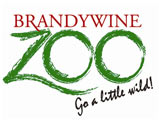Brandywine Zoo

Brandywine Zoo Logo
|
|
| Date opened | 1905 |
|---|---|
| Location | 1001 North Park Drive, Brandywine Park, Wilmington, Delaware, United States 19802 |
| Coordinates | 39°45′20″N 75°32′55″W / 39.7555°N 75.5487°WCoordinates: 39°45′20″N 75°32′55″W / 39.7555°N 75.5487°W |
| Land area | 12 acres (4.9 ha) |
| No. of animals | 150 |
| No. of species | 58 |
| Memberships | AZA |
| Website | www.brandywinezoo.org |
Brandywine Zoo is a small 12-acre (4.9 ha) zoo that opened in 1905 in Brandywine Park in Wilmington, Delaware, United States. It is located on the banks of the Brandywine River. The zoo is managed by the Delaware Division of Parks and Recreation and supported by the Delaware Zoological Society, and is open daily weather permitting.
The Brandywine Zoo has been a member of the Association of Zoos and Aquariums (AZA) since 1981.
In March 1883, the Delaware State Legislature passed a law forming the Wilmington Board of Park Commissioners. Ten unpaid men were appointed to the Board to plan and build Wilmington parks. Eventually their effort yielded Brandywine, Rockford and Canby parks.
The Commissioners hired Frederick Law Olmsted, the famous landscape architect to find the best places to house these parks. He suggested the City purchase land on both sides of the Brandywine River. Olmsted planned the park as he planned Central Park in New York City and the Boston Commons in Massachusetts. In 1886, the land was purchased and Olmsted went to work.
Right across the river from where the current zoo is located lived an Irishman named Archibald Rowan. He made the first printed cloth in Delaware. On the land where the zoo now stands, there was a public amphitheater where people would go to hear famous orators of their time. Among them were Daniel Webster, John C. Calhoun and Henry Clay. It is even said that George Washington mustered his troops on the field above the zoo near the Washington Street Bridge during the American Revolution. In 1904, Dr. James H. Morgan came to the Board of Park Commissioners with the idea of starting a zoo in Wilmington. He was able to donate some animals if the Commission would pay for the shelters and fences. The boundaries of the zoo were very different from today. The main area of the zoo was the area of the old bear pit (across from the current Andean condor exhibit) and the Exotic Animal House, and extended down the river. Ducks and geese, Belgian hares, a sea turtle, and a sea gull were among the original collection.
...
Wikipedia
